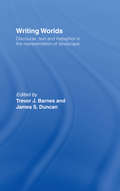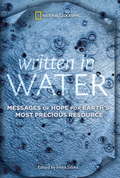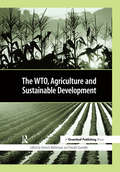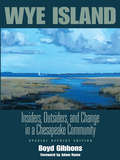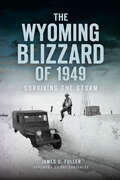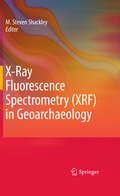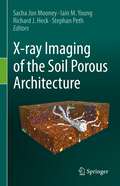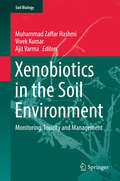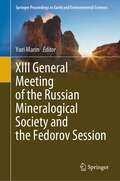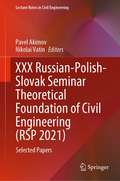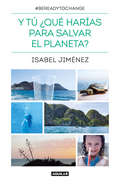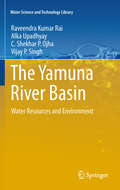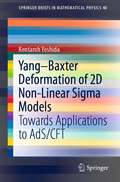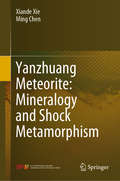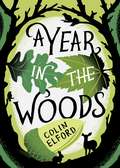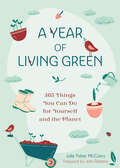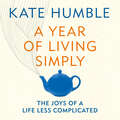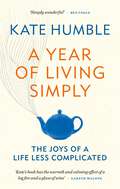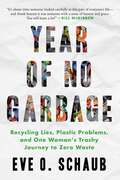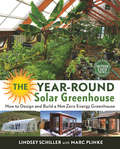- Table View
- List View
Writing Worlds: Discourse, Text and Metaphor in the Representation of Landscape
by Trevor J. Barnes James S. DuncanWriting Worlds represents the first systematic attempt to apply poststructuralist ideas to landscape representation. Landscape - city, countryside and wilderness - is explored through the discourse of economics, geopolitics and urban planning, travellers descriptions, propaganda maps, cartography and geometry, poetry and painting. The book aims to deconstruct geographical representation in order to explore the dynamics of power in the way we see the world.
Written in Water
by Irena SalinaWritten in Water: Messages of Hope for Earth's Most Precious Resource comprises a collection of essays authored by heroes and leaders in the field of water solutions and innovations--a broad range of people from varied disciplines who have contributed their hearts and minds to bringing awareness to and conserving Earth's freshwater supply. In their own words, authors tell of such tragedies as water slavery, drought, or contamination, as well as their own professional struggles and successes in pursuit of freshwater solutions. Contributors include: Alexandra Cousteau, social environmental advocate and granddaughter of legendary marine scientist Jacques Cousteau; Peter Gleick, environmental visionary and winner of a 2003 MacArthur "genius grant"; Bill McKibben, bestselling author and winner of a Guggenheim fellowship; Sylvia Earle, oceanographer and Time magazine's first "hero for the planet"; and Christine Todd Whitman, former head of the Environmental Protection Agency, along with more than a dozen other notable people.These visionaries' stories touch, surprise, and amaze as they help us see the essential role played by water in our world, our lives, and our future. These are all people who are thinking far beyond the realm of self; they are devoted to creating a better world for all of us.
Written in Water
by Irena SalinaWritten in Water is an unforgettable collection of the true stories of people-men and women, politicians and scientists, laymen and experts-sharing in their own words what they have seen and what they have learned in their efforts to bring clean water to all.
The WTO, Agriculture and Sustainable Development
by Heinrich Wohlmeyer Theodor QuendlerDespite the Doha declaration of November 2001, the failure to start a new round of global trade negotiations at Seattle in December 1999 and the hostility of protesters to the trade liberalization process and growing global economic and social disparities was a wake-up call for the World Trade Organisation (WTO). The ambitious goal of this ground-breaking book is to identify the strengths and weaknesses of liberalized world trade, in particular in the agricultural sector, and to investigate to what extent the current WTO agreements provide the necessary fail-safe devices to react to trade-related negative impacts on sustainability, environmental protection and food security. The background and interrelationship between the WTO, the tenets of sustainable development and the unique features of the agriculture and forestry sectors are explored, and conclusions regarding the deficits of the world trade system and its conflicts with basic societal goals – such as sustainability – are drawn. Agriculture and forestry have a particular affinity with what the authors call "strong sustainability" and are to be among the major agenda items in forthcoming WTO negotiations. The book proposes that sustainable agricultural production techniques such as integrated and organic farming provide a series of related services to community and environment which could be severely prejudiced by wholesale trade liberalization and the imposition of the large-scale production methods of the mega-trade giants of the USA and Europe. And yet the concept of sustainability is referred to only tangentially in the existing WTO agenda. The WTO, Agriculture and Sustainable Development argues that, without a formal recognition of this failing, the premise that free trade is inherently advantageous for all countries is a falsehood. Further, unfettered liberalization is unsustainable and a social and environmental multilateral framework must be agreed to reinterpret or adapt a host of WTO regulations that are at odds with sustainable development. The core problem is that, under the current system, import duties can only be differentiated by direct goods and services and not by their means of production – sustainable or otherwise. Therefore, a range of environmental policy measures in the agricultural sector, such as the consideration of product life-cycles, the internalization of external costs and a coupling of trade liberalization with ecological obligations are proposed by the authors. In addition, they argue that unsustainable economic short-termism must be curbed and the use of the stick of trade sanctions and the carrot of financial benefits for good environmental performance be permitted to promote sustainable agricultural practices. This book will contribute greatly in addressing the lack of basic theoretical arguments at the intersection between trade and sustainable development – a failing that has already been bemoaned by trade policy-makers. It is highly recommended reading for all those involved or interested in the WTO negotiations, whether from multilateral organizations, governments, industry or civil society.
Wye Island: Insiders, Outsiders, and Change in a Chesapeake Community - Special Reprint Edition
by Boyd GibbonsToday, most of the 2,800 tranquil acres that make up Wye Island are managed by the Maryland Park Service. However, from 1973 to 1974, the island was the site of a raging controversy. A major developer, James Rouse, wanted to build a compact waterfront village that would be surrounded by large estates, protected farms, and wetlands. A boyhood resident of nearby Easton, Maryland, Rouse hoped that the island could avoid the sprawl of unplanned subdivisions that were marring so many other places along the Eastern Shore. Combining history, journalism, character sketches, and sharp sociological insight, Boyd Gibbons presents the conflict over Wye Island in its multiple dimensions - as an example of the emerging community-based activism of the 1960s and 70s, and of a community that, while exercising its right to preserve its identity, denies opportunities for its members to improve their lives through change. In fact, Wye Island proves not to be the environmental David-Goliath struggle that might be expected. For one thing, residents opposed a development plan that can be regarded as an early model for 'smart growth.' And many were no more favorably disposed to a park or preserve than to a planned village. Their interest was in protecting the community from an invasion of immigrants from ethnically diverse Baltimore and Washington, and, where the wealthy were concerned, protecting some very private views of the water. In the end, rich landowners, poor 'natives,' and many recent newcomers opposed the Rouse project - distrusting change, and, above all, fearing 'outsiders.' The special reprint of Wye Island includes a new foreword by distinguished environmental historian Adam Rome, who explores the enduring themes of Wye Island in context of the current debates about land use, development, and sprawl.
The Wyoming Blizzard of 1949: Surviving the Storm (Disaster)
by James C FullerA Wyoming historian shares an in-depth look at the historic storm and its devastating aftermath through the stories of those who survived. The Blizzard of 1949 took Wyoming and neighboring states by surprise. In January of that year, snow, wind and frigid temperatures devastated the northern plains. The storm stranded hundreds of motorists on the highways and stalled nearly two dozen trains at depots throughout the state. For nearly two months, towns and ranches were marooned by enormous drifts, some reportedly eighty feet tall. Communities pulled together to assist not only their neighbors but also anyone unable to escape the snowstorm. Drawing on meticulous research and numerous in-person interviews, author and historian James Fuller recounts these harrowing stories of tenacity and fortitude.
X-Ray Fluorescence Spectrometry (XRF) in Geoarchaeology
by M. Steven ShackleySince the 1960s, x-ray fluorescence spectrometry (XRF), both wavelength and energy-dispersive have served as the workhorse for non-destructive and destructive analyses of archaeological materials. Recently eclipsed by other instrumentation such as LA-ICP-MS, XRF remains the mainstay of non-destructive chemical analyses in archaeology, particularly for volcanic rocks, and most particularly for obsidian. In a world where heritage and repatriation issues drive archaeological method and theory, XRF remains an important tool for understanding the human past, and will remain so for decades to come. Currently, there is no comprehensive book in XRF applications in archaeology at a time when the applications of portable XRF and desktop XRF instrumentation are exploding particularly in anthropology and archaeology departments worldwide. The contributors to this volume are the experts in the field, and most are at the forefront of the newest applications of XRF to archaeological problems. It covers all relevant aspects of the field for those using the newest XRF technologies to deal with very current issues in archaeology.
X-ray Imaging of the Soil Porous Architecture
by Sacha Jon Mooney Iain M. Young Richard J. Heck Stephan PethThe advent of X-ray Computed Tomography (CT) as a tool for the soil sciences almost 40 years ago has revolutionised the field. Soil is the fragile, thin layer of material that exists above earth’s geological substrates upon which so much of life on earth depends. However a major limitation to our understanding of how soils behave and function is due to its complex, opaque structure that hinders our ability to assess its porous architecture without disturbance. X-ray imagery has facilitated the ability to truly observe soil as it exists in three dimensions and across contrasting spatial and temporal scales in the field in an undisturbed fashion. This book gives a comprehensive overview of the “state of the art” in a variety of application areas where this type of imaging is used, including soil water physics and hydrology, agronomic management of soils, and soil-plant-microbe interactions. It provides the necessary details for entry level readers in the crucial areas of sample preparation, scanner optimisation and image processing and analysis. Drawing on experts across the globe, from both academia and industry, the book covers the necessary “dos and don’ts”, but also offers insights into the future of both technology and science. The wider application of the book is provided by dedicated chapters on how the data from such imagery can be incorporated into models and how the technology can be interfaced with other relevant technical applications. The book ends with a future outlook from the four editors, each of whom has over 20 years of experience in the application of X-ray CT to soil science.
Xenobiotics in the Soil Environment
by Muhammad Zaffar Hashmi Vivek Kumar Ajit VarmaThis book describes the vast variety of xenobiotics, such as pesticides, antibiotics, antibiotic resistance genes, agrochemicals and other pollutants, their interactions with the soil environment, and the currently available strategies and techniques for soil decontamination and bioremediation. Topics covered include: transport mechanisms of pollutants along the Himalayas; use of earthworms in biomonitoring; metagenomic strategies for assessing contaminated sites; xenobiotics in the food chain; phyto-chemical remediation; biodegradation by fungi; and the use of enzymes and potential microbes in biotransformation. Accordingly, the book offers a valuable guide for scientists in the fields of environmental ecology, soil and food sciences, agriculture, and applied microbiology.
XIII General Meeting of the Russian Mineralogical Society and the Fedorov Session (Springer Proceedings in Earth and Environmental Sciences)
by Yuri MarinThis book presents the materials of the XIII General Meeting of the Russian Mineralogical Society. Over 190 participants prepared the result of their scientific work on mineralogy: mineral diversity and the evolution of mineral formation (S1); minerals as markers of petro- and ore genesis and new methods of their determination (S2); mineralogy and formation conditions of deposits of strategic minerals (S3); problems of applied (technological and ecological) mineralogy and geochemistry (S4); natural stone in art and architecture (S5); modern research in the field of stone and gemological studies (S6); mineralogical crystallography, crystallochemistry, and new minerals (F1); history of science, museumification, and popularization of natural science knowledge (F2). The Russian Mineralogical Society is the oldest mineralogical Society in Russia (from 1817). The Russian Mineralogical Society joins more than 1200 researchers from universities, academic and industry institutes, and production organizations in Russia's major scientific centers. The Society has 17 sections, including crystallochemistry, radiography and spectroscopy of minerals, ore mineralogy, technological mineralogy, experimental mineralogy, ecological mineralogy and geochemistry, and new mineral nomenclature classification. The main scientific and organizing event for the Russian Mineralogical members is the meeting session, organized every fourth year.
XXX Russian-Polish-Slovak Seminar Theoretical Foundation of Civil Engineering: Selected Papers (Lecture Notes in Civil Engineering #189)
by Pavel Akimov Nikolai VatinThis book gathers the latest advances, innovations, and applications in the field of civil, environmental and construction engineering, as presented by researchers and engineers at the XXX Annual Russian-Polish-Slovak Seminar Theoretical Foundation of Civil Engineering (RSP), held in September 2021. Co-organized by six universities from Russia, Poland and Slovakia, the event covered diverse topics such as structural mechanics; building structures; geodesy and geotechnics; transport and environmental issues in civil engineering. The contributions, which were selected by means of a rigorous international peer-review process, highlight numerous exciting ideas that will spur novel research directions and foster multidisciplinary collaborations.
Y tú ¿qué harías para salvar el planeta?
by Isabel JiménezUn ensayo periodístico comprometido y valiente que aporta alternativas y soluciones a la contaminación producidad por el plástico. «No se trata de volver al pasado, se trata de buscar un futuro en el que tenga cabida el progreso, pero con soluciones sostenibles a los residuos. Apostemos por el consumo responsable», escribe Isabel Jiménez en Y tú ¿qué harías para salvar el planeta? Uno de los rostros más respetados de la televisión muestra su compromiso con la sostenibilidad y el medioambiente en un tema que exige soluciones ya: la reducción del consumo de plástico. El futuro del planeta está en nuestras manos, y la solución al problema también. Hay esperanza: todavía estamos a tiempo para cambiar el futuro. Es posible un consumo responsable que permita una reducción drástica de los plásticos de un solo uso. Se puede caminar hacia un nuevo modelo de producción más acorde con la naturaleza. Es hora de apostar por la economía circular: «Hacer más con menos, reducir la materia prima y reutilizar». Y el compromiso es de todos: de los gobiernos, de los empresarios, de los activistas públicos, de los ciudadanos y del propio sector del plástico. En palabras de la autora: «A todos nos debería importar qué está pasando en los mares, en los ríos y en los océanos». Convirtámonos en la generación del cambio, salvemos el planeta. Y tú ¿qué harías para salvar el planeta? es un nuevo reto en la carrera profesional de la periodista Isabel Jiménez. En sus páginas muestra su compromiso con el medioambiente y deja el sello de su estilo: rigor informativo y cercanía para convertir en realidad un objetivo necesario.
The Yamuna River Basin
by Alka Upadhyay C. Shekhar Ojha Raveendra Kumar Rai Vijay P. SinghThis book is designed to provide concepts, methodologies, and approaches for river basin studies with respect to water resources and environment. The book is not limited to the Yamuna River basin, but will help in the study of various other river basins for integrated water resources management. The book covers the essential components of integrated water resources management, including analysis of climatic variables, climate change detection, analysis of natural resources, geology, geomorphology, socio-economics, water budgeting, flood estimation, river pollution, etc. Furthermore, the book addresses recent issues pertaining to water quality, water quality indices, environmental flows, water resources management through cropping pattern change, etc. along with methodologies and application to the Yamuna River system. However, the main objective of this book is to address important issues of water resources management of river basins. Audience: The manuscript has been designed so that it can be used as a reference for river basin studies. The book will be useful to engineers, agricultural scientists, environmentalists, planners, managers, and administrators who are concerned with water resources.
Yang–Baxter Deformation of 2D Non-Linear Sigma Models: Towards Applications to AdS/CFT (SpringerBriefs in Mathematical Physics #40)
by Kentaroh YoshidaIn mathematical physics, one of the fascinating issues is the study of integrable systems. In particular, non-perturbative techniques that have been developed have triggered significant insight for real physics. There are basically two notions of integrability: classical integrability and quantum integrability. In this book, the focus is on the former, classical integrability. When the system has a finite number of degrees of freedom, it has been well captured by the Arnold–Liouville theorem. However, when the number of degrees of freedom is infinite, as in classical field theories, the integrable structure is enriched profoundly. In fact, the study of classically integrable field theories has a long history and various kinds of techniques, including the classical inverse scattering method, which have been developed so far. In previously published books, these techniques have been collected and well described and are easy to find in traditional, standard textbooks. One of the intriguing subjects in classically integrable systems is the investigation of deformations preserving integrability. Usually, it is not considered systematic to perform such a deformation, and one must study systems case by case and show the integrability of the deformed systems by constructing the associated Lax pair or action-angle variables. Recently, a new, systematic method to perform integrable deformations of 2D non-linear sigma models was developed. It was invented by C. Klimcik in 2002, and the integrability of the deformed sigma models was shown in 2008. The original work was done for 2D principal chiral models, but it has been generalized in various directions nowadays. In this book, the recent progress on this Yang–Baxter deformation is described in a pedagogical manner, including some simple examples. Applications of Yang–Baxter deformation to string theory are also described briefly.
Yanzhuang Meteorite: Mineralogy and Shock Metamorphism
by Ming Chen Xiande XieThis book investigates the mineralogy and shock effects of Yanzhuang chondrite, using modern micro-mineralogical experimental techniques, including SEM, TEM, EPMA, Raman microprobe spectroscopy, instrumental neutron activation analysis, X-ray micro-diffraction analysis, micro-PIXE analysis and laser ablation ICP-MS. The micro-structural and micro-morphological characteristics as well as chemical composition of minerals were studied in details. Based on the studies in the shock effects of rocks and minerals, and the detailed study in the shock-produced melt, the book concludes that Yanzhuang chondrite is the most heavily shocked ordinary H group chondrite ever found and that it contains the most abundant shock induced melt among all known shock-melt-bearing chondritic meteorites.
A Year in the City (Season to Season)
by Christina Mia GardeskiFrom snow plows to skyscraper nests and rooftop gardens, life in the city changes from season to season. Discover what animals live in the city. Learn how smog forms in summer. Real-life photographs follow the seasons and capture the beauty of a year in the city.
A Year in the Forest (Season to Season)
by Christina Mia GardeskiFrom hibernation to baby animals and falling leaves, life in the forest changes from season to season. Discover why snow is good for trees. Learn how wildfires help the forest grow. Real-life photographs follow the seasons and capture the beauty of a year in the forest.
A Year in the Pond (Season to Season)
by Christina Mia GardeskiFrom ice skating to tadpoles and migrating birds, life in the pond changes from season to season. Discover how fish stay warm in winter. Learn why butterflies fly away in fall. Real-life photographs follow the seasons and capture the beauty of a year in the pond.
A Year in the Woods: The Diary of a Forest Ranger
by Colin ElfordColin Elford's A Year in the Woods is an enthralling journey into the heart of the English countryside - with a preamble by Craig Taylor.Colin Elford spends his days alone - alone but for the deer, the squirrels, the rabbits, the birds, and the many other creatures inhabiting the woods.From the crisp cold of January, through the promise of spring and the heat of summer, and then into damp autumn and the chill winds of winter, we accompany the forest-ranger as he goes about his work - stalking in the early morning darkness, putting an injured fallow buck out of its misery, watching stoats kill a hare, observing owls, and simply being a part of the outdoors.Colin Elford immerses himself in the richly diverse and unique landscapes of Britain, existing in rhythm with natural environments. For fans of Robert Macfarlane's Landmarks, Helen Macdonald's H is for Hawk orJames Rebanks' A Shepherd's Life, Colin's rare and uplifiting journey will unveil the true nature and beauty of Britain's countryside.'This is nature for real . . . Elford describes woodland wonders in short paragraphs of luminous intensity' Daily Mail'A poetic insight in the world of hidden Nature' Countryman'Stalking sharpens the senses and there is an almost hallucinatory clarity to Elford's writing' Observer'Refreshingly unsentimental. Contains some wonderful descriptions and sentences which are so profound they demand a second reading' Sunday ExpressColin Elford is a forest ranger on the Dorset/Wiltshire border. Craig Taylor is the author of Return to Akenfield and One Million Tiny Plays About Britain and the editor of the magazine Five Dials.
A Year of Living Green: 365 Things You Can Do for Yourself and the Planet
by Julie Fisher-McGarryDwell Well and Build a Better World“This book offers a low-impact lifestyle that will make your daily life easier and positively affect the Earth for generations to come.” —Cheryl Hahn, founder and president of Tomorrow's WorldA Year of Living Green is a daily chronicle or journal from author Julie Fisher-McGarry to help keep your mind and heart open to all that lives.Have a positive impact on the world.A Year of Living Green is a collection of nonreligious, yet deeply soulful suggestions for demonstrating concern, kindness, and consideration for nature and its animals. Organized by month, it includes tips on living green, where to purchase organic and fair-trade products, how to unplug from the grid, supporting local economies, nourishing the earth, and creating a sustainable lifestyle. Julie offers you daily personal anecdotes, inspiring quotations, verses of poetry, simple vegetarian recipes, women’s health tips, environmental facts, and green thoughts.Written especially for women. Julie Fisher-McGarry was once a personal fitness trainer to Saudi Arabian royalty, and now works to promote environmental issues in every way she can. A vegetarian since the 1980s, she has fought against animal cruelty and promoted better human health. A Year of Living Green was written especially for women because Julie believes that women are less afraid to show emotion and act upon it.Get a copy of A Year of Living Green and…Discover why individual acts really do matterLearn how to start small and make a big differenceSee how simple acts can inspire others and help build a better worldKeep a journal as you read along so that you can record your own green and compassionate ideas, plans, and daily actsIf you have read and learned from books such as The Four Agreements, A New Earth, The Path Made Clear, Have You Seen Luis Velez, No One Is Too Small to Make a Difference, Let it Go, or Pay It Forward; you will love A Year of Living Green.
A Year of Living Simply: The joys of a life less complicated
by Kate Humble'Simply wonderful.' - BEN FOGLE'Kate's book has the warmth and calming effect of a log fire and a glass of wine. Unknit your brow and let go. It's a treat.' - GARETH MALONE'Kate Humble pours her enviable knowledge into attainable goals. It's a winning combination and the prize - a life in balance with nature - is definitely worth claiming.' - LUCY SIEGLE'As ever, where Kate leads, I follow. She has made me reassess and reset.' - DAN SNOWIf there is one thing that most of us aspire to, it is, simply, to be happy. And yet attaining happiness has become, it appears, anything but simple. Having stuff - The Latest, The Newest, The Best Yet - is all too often peddled as the sure fire route to happiness. So why then, in our consumer-driven society, is depression, stress and anxiety ever more common, affecting every strata of society and every age, even, worryingly, the very young? Why is it, when we have so much, that many of us still feel we are missing something and the rush of pleasure when we buy something new turns so quickly into a feeling of emptiness, or purposelessness, or guilt?So what is the route to real, deep, long lasting happiness? Could it be that our lives have just become overly crowded, that we've lost sight of the things - the simple things - that give a sense of achievement, a feeling of joy or excitement? That make us happy. Do we need to take a step back, reprioritise? Do we need to make our lives more simple? Kate Humble's fresh and frank exploration of a stripped-back approach to life is uplifting, engaging and inspiring - and will help us all find balance and happiness every day.(p) 2020 Octopus Publishing Group
A Year of Living Simply: The joys of a life less complicated (Kate Humble)
by Kate Humble'Simply wonderful.' - BEN FOGLE'Kate's book has the warmth and calming effect of a log fire and a glass of wine. Unknit your brow and let go. It's a treat.' - GARETH MALONE'Kate Humble pours her enviable knowledge into attainable goals. It's a winning combination and the prize - a life in balance with nature - is definitely worth claiming.' - LUCY SIEGLE'As ever, where Kate leads, I follow. She has made me reassess and reset.' - DAN SNOW'Kate Humble's new book is a lesson in moving on from a tragedy and finding our place in the world' - WOMAN & HOME'A Year of Living Simply is timely, given that the pandemic has forced most of us, in some way to simplify our lives, whether we planned to or not. Kate wrote it before any of us were aware of the upcoming crisis, but it captures the current moment perfectly... It's not necessarily a "how to" book, more of a "why not try?" approach.' - FRANCESCA BABB, MAIL ON SUNDAY YOU'What I particularly love is her philosophy for happiness, which is the subject of her new book, A Year of Living Simply. The clue is in the title. Remember the basics. Instead of barging through the day on autopilot, really stop to think about the tiniest little things that added a moment of joy. No, of course stopping and smelling the flowers won't cure all our ills and woes. But taking the time to savour the things that bring pleasure, really being in that moment and appreciating it, can remind you that most days have moments that buoy your mood.' - JO ELVIN, MAIL ON SUNDAY YOUIf there is one thing that most of us aspire to, it is, simply, to be happy. And yet attaining happiness has become, it appears, anything but simple. Having stuff - The Latest, The Newest, The Best Yet - is all too often peddled as the sure fire route to happiness. So why then, in our consumer-driven society, is depression, stress and anxiety ever more common, affecting every strata of society and every age, even, worryingly, the very young? Why is it, when we have so much, that many of us still feel we are missing something and the rush of pleasure when we buy something new turns so quickly into a feeling of emptiness, or purposelessness, or guilt?So what is the route to real, deep, long lasting happiness? Could it be that our lives have just become overly crowded, that we've lost sight of the things - the simple things - that give a sense of achievement, a feeling of joy or excitement? That make us happy. Do we need to take a step back, reprioritise? Do we need to make our lives more simple? Kate Humble's fresh and frank exploration of a stripped-back approach to life is uplifting, engaging and inspiring - and will help us all find balance and happiness every day.
Year of No Garbage: Recycling Lies, Plastic Problems, and One Woman's Trashy Journey to Zero Waste
by Eve O. Schaub"Eve&’s brave and honest experiment reveals the shocking impact of the throwaway society we&’ve become and at the same time showing small ways we can all do better.&” —Rebecca Prince-Ruiz, founder of Plastic Free JulyYear of No Garbage is Super Size Me meets the environmental movement. In this book Eve O. Schaub, humorist and stunt memoirist extraordinaire, tackles her most difficult challenge to date: garbage. Convincing her husband and two daughters to go along with her, Schaub attempts the seemingly impossible: living in the modern world without creating any trash at all. For an entire year. And- as it turns out- during a pandemic. In the process, Schaub learns some startling things: that modern recycling is broken, and single stream recycling is a lie. That flushable wipes aren&’t flushable and compostables aren&’t compostable. That plastic drives climate change, fosters racism, and is poisoning the environment and our bodies at alarming rates, as microplastics are being found everywhere, from the top of Mount Everest to the placenta of unborn babies. If you&’ve ever thought twice about that plastic straw in your drink, you&’re gonna want to read this book.
A Year on the Farm (Season to Season)
by Christina Mia GardeskiFrom mending fences to seedlings and combines, life on the farm changes from season to season. Discover what farmers do in winter. Learn how crops are harvested in fall. Real-life photographs follow the seasons and capture the beauty of a year on the farm.
The Year-Round Solar Greenhouse: How to Design and Build a Net-Zero Energy Greenhouse
by Lindsey Schiller Marc PlinkeComprehensive coverage of passive solar greenhouse design including material selection, building methods and how to store thermal energy using a variety of simple and innovative strategies. Over a dozen case studies provide real-life inspiration, capped off with how-to guidance for building a durable, energy-efficient greenhouse. Variations include underground and aquaponic greenhouses and integrating solar panels to grow off-grid, year-round.
